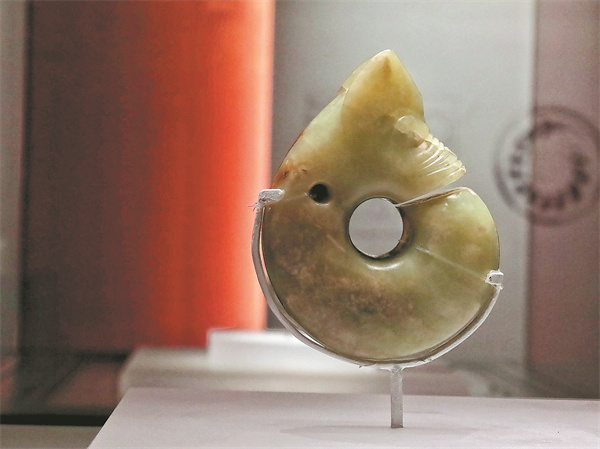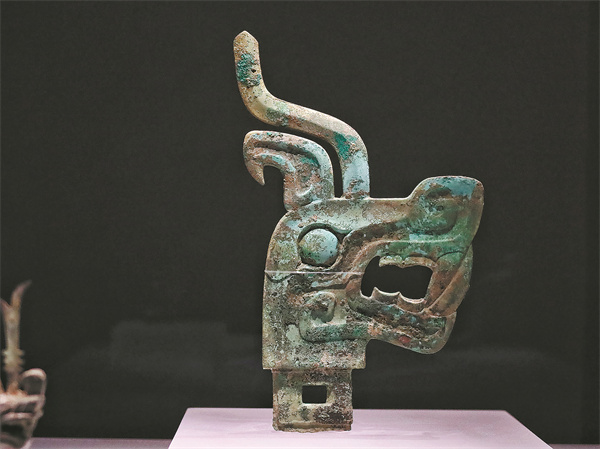Silkroads News
Fantastical flying beasts-Major Beijing exhibition traces history of the dragon through 8,000 years of imagery, Wang Ru reports.

In China, the dragon has special and enduring cultural connotations. With this year marking the Year of Dragon, the fifth animal in the traditional Chinese zodiac, there are dragon decorations everywhere. In fact, the first dragon images were being made about 8,000 years ago. Since then, a dazzling number of exquisite artifacts have been created using this motif.
An ongoing exhibition at the Chinese Archaeological Museum in Beijing has gathered together many such artifacts. The exhibition kicked off on May 1, and will run until Dec 31. It is a display of 112 objects unearthed at 30 important archaeological sites around the country.
These include the Archaeological Ruins of Liangzhu City, a UNESCO World Heritage Site which dates back for 4,300 to 5,300 years in Hangzhou, Zhejiang province; the Erlitou Site, widely believed to be a late capital of the Xia Dynasty (c. 21st century-16th century BC) in Luoyang, Henan province; the Yinxu Ruins, a late Shang Dynasty (c. 16th century-11th century BC) capital in Anyang, Henan, and the Sanxingdui Site in Guanghan, Sichuan province, which dates back to over 3,000 years.

At the opening ceremony on April 29, Ma Yuan, deputy secretary-general of the Chinese Academy of Social Sciences, said that through artifacts, photos, videos and 3D displays, the exhibition elaborates on the origins, development and evolution of dragon culture, as well as the historical value and modern significance of the dragon as a national totem.
According to Guo Wu, a researcher at the Institute of Archaeology at CASS, the dragon is one of the most important Chinese totems. It is believed to be closely connected to the formation of the Chinese state and civilization. As a result, the dragon can still be seen everywhere and is beloved by the people.
"We want to show images of the dragon's 8,000-year history in China to allow visitors to understand how it has gradually evolved alongside the formation of China, and what it is like today," says Guo.
The exhibition opens with photos of the earliest-known dragon image from the Chahai Site in Fuxin, Liaoning province, which is made out of stacked stones from about 8,000 years ago. The image is 19.7 meters long and has a recognizable head, body and tail, and is inferred to have been used in sacrificial ceremonies.

Guo says archaeological evidence reveals that before the Xia and Shang dynasties, people from different areas made dragon totems, although those images differed, as features of animals they liked or believed to be mysterious, like the crocodile, the snake, the pig and the bear, were integrated with those of the dragon.
For example, a dragon image from the Taosi Site in Xiangfen county, Shanxi province, which dates from about 4,000 years ago, has a body similar to a snake, while one from Hongshan Culture, a key Neolithic culture that existed between 6,500 to 5,000 years ago in northern China, has fangs and a mane. An image from the Lingjiatan Site in Hanshan county, Anhui province, which dates back to between 5,800 and 5,300 years ago, has horns on its head. All these features can be seen in the exhibits, says Guo.

Meanwhile, the dragons found on Shang Dynasty relics reveal that the Shang people incorporated many of these features into their depictions, ultimately leading to the creation of a fixed dragon image, Guo says.
"Shang dragons often exhibit characteristics like horns on their heads, bodies resembling snakes or crocodiles, fangs and manes. … This means that with the rise of monarchies controlling large areas, dragon depictions transitioned from being varied and scattered to becoming unified for the first time," says Guo.
The exhibition highlights a number of dragon artifacts from before the Xia and Shang dynasties, including a C-shaped jade dragon, one of the typical formats of jade dragons made by the Hongshan Culture, which was discovered in Inner Mongolia autonomous region.
"The jade dragon's snout protrudes forward and lifts upward, and it has a relatively long mane on its back. …The dragon is presented in a soaring and upward-flying state, and embodies the aesthetics of ancient people, who adopted a minimalist approach in its making," says Li.
Another typical Hongshan Culture jade pig-dragon (a jade dragon with the features of a pig) is also on display. Visitors are not only able to see the image, but can also get to know exactly where it was found through photos of the site.

"We have added archaeological background information for the artifacts. You can find out in which tomb at the Niuheliang Site in Chaoyang, Liaoning province, the dragon was discovered, down to details such as the fact that it was placed on the chest of a dead person. In this way, we offer complete information about the artifacts, so visitors can quickly understand the lineage of dragons in China," says Guo.
Over time, the dragon has evolved into a cultural symbol, with people attributing spiritual qualities to the mythical creature, among them uprightness and a relentless pursuit of self-improvement. These qualities are also regarded as part of the spirit of China, according to Guo.
He mentions that another influential change to the dragon image took place during the Southern Song era (1127-1279), when Chen Rong painted dragons in a way that conveyed their twisting and turning movements in the sky, with parts of their bodies hidden by clouds. This particular representation of dragon has endured through the ages and is still widespread today.
Moreover, says Guo, dragon totem artifacts are a reflection of the characteristics of Chinese civilization.
"Since (the dragon) has a long history, it shows the continuity of Chinese civilization. The changes to its image show creativity. It also shows peacefulness, as the dragon was originally believed to be connected with celestial phenomena associated with agriculture, and was often thought to control rainfall, which was vital to agricultural society.
"As a result, people worshipped the dragon to pray for good weather for their crops. It's totally different from the Western concept of the dragon."
Dragon artifacts also demonstrate the inclusiveness of Chinese civilization. For example, a gold necklace from the Western Jin Dynasty (265-316) unearthed in Inner Mongolia blends different cultural features. The necklace has dragon heads on both ends, and is decorated with small models of traditional Chinese weapons like shields, ji, or polearms, and yue, a kind of axe.
Guo says it has obvious Scythian (nomadic tribes that flourished between the 7th century BC and 4th century AD), Gandharan and Indian elements, and that the dragon and the weapon decorations are typically Chinese. As a result, the necklace is evidence of cultural communication.
Many of the exhibits are extremely precious and it was not easy to assemble them.
Some are newly unearthed and are being exhibited for the first time. For example, the dragon pieced together from clam shells dating to about 6,300 years ago, was found at the Caitaopo Site in Chifeng, Inner Mongolia last year.
"This is a dragon artifact that dates back to the early period of Hongshan Culture. Unlike the jade pig-dragon of the late Hongshan Culture period, which has a curled body, this one seems to be elongated, filling in a gap in early Hongshan dragon imagery," says Guo.
Another from the Lingjiatan Site, which was unearthed in 2022, takes a special form. The artifact is tubelike, with one end carved like a dragon head lifting its head, and the other end a pointed cone shape.
"This is the only example of this form of dragon found so far, and we haven't been able to determine what it was used for," says Guo.
With a chronological sequence spanning 8,000 years of dragon culture, and its collection of the most representative artifacts, Ma says the exhibition is expected to play a crucial role in promoting and disseminating dragon culture during the Year of the Dragon.
"I had never seen so many artifacts with dragon elements brought together in the past," says Wang Mingda, a veteran archaeologist who worked at Liangzhu for decades. "I have seen and even handled some of the exhibits as part of my work, but I have never seen them all together before."
Category: English
News
Silkroads News
Key words:
